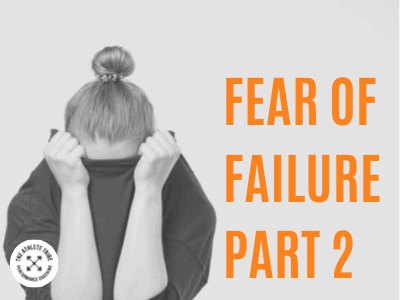In part one of my “Fear of Failure” performance resource, I discussed how a fear of failure could have huge implications when it comes to performance. In part two, I will provide you with the necessary tools to overcome your fear.
4 Ways to Not Be Afraid of Failure
We all want to succeed without facing the unbearable, humiliating, and often overwhelming feeling of failure. But can you think of even one person who’s never failed in life?
The short answer is NO.
We all face failure at some point in our lives, and if you’re able to move on from your failures, you will be able to use them as a springboard for success. So how do you get over this fear?
Analyze All Potential Outcomes:
Before you take action, you need to be able to see the possible outcomes of the various decisions you might make. If you can get an accurate picture of what’s going to happen, you’ll be able to know for sure whether or not a certain path is going to work out for you. This will give you some control over your life and the way you experience the fear of failure.
You Must Learn to Think Positively:
If you are in a fearful state of mind, you’ll find that you’re not as focused as you could be. Fear is very distracting, and it’s hard to be calm and collected when you’re worried about something. So, what you need to do is learn to get yourself into a more relaxed state of mind so that you can think clearly.
For example, if you have to give a presentation, you may be afraid that people are going to criticize it. To get yourself into a positive state of mind, try listening to some soothing music or reading something motivational. Take a look at the CO2 tolerance video I made talking about how to change your state and help you think positively here.
Look at the Worst-Case Scenario:
Instead of trying to figure out what you’re going to do if everything goes according to plan, try figuring out what you’re going to do if it all goes wrong. When you look at the potential outcomes of any situation, figure out what the worst-case scenario is and then write out a plan of action for dealing with it. This will help you feel better prepared and less likely to be distracted by worry.
Always Have a Contingency Plan:
The one thing you’ll never regret is having the option to change your mind. If you’re not sure about something, make sure you have a backup plan in case things don’t work out the way you hoped. When you have a backup plan, you’ll be more willing to take risks and more confident in your abilities. This will put you in a positive frame of mind and help you be more open to new opportunities.
How to Stop Living in Fear
You have to stop living in fear, break free from your limiting beliefs, and begin to live the life you were meant to have. The first step is to acknowledge your fear. Accept it for what it is, and understand it. If you can come to understand the roots of your fear, then you can begin to unravel them.
Fear comes from so many places, but for many people, it comes from past traumatic experiences in their lives. Maybe you’ve experienced bullying or trauma at school, a traumatic divorce, or some other form of trauma. Whatever the situation maybe, if you can look at it with a clear mind and open heart, you can start to move past the fear and into a space of strength and understanding.
I recommend setting up small victories in order to help conquer the fear of failure. A small, achievable goal that you set for yourself can give you the momentum that you need to move forward. When you’re taking a big risk or trying something new, your subconscious mind might resist and kick up all kinds of fearful emotions. To get past those feelings, try to break down the process into small, manageable steps. Then you can feel confident and strong about what you’re doing.
Another important thing to consider is visualization. When you imagine yourself successfully conquering your fear, it can help bring your goal closer to you. It will give you the clarity and confidence that you need to move forward in your life. You can use visualization and meditation to help quiet your mind and gain a better understanding of yourself. By using these two techniques, you can retrain your mind to see things in a positive light.
You can also take things into your own hands by consciously deciding that you’re going to stop living in fear. If there’s something that you’ve always wanted to do, but you’ve been afraid to go for it, then make a decision right now to stop worrying about the outcome and just go for it. It might not be easy at first, but eventually, you’ll be moving forward with your life and conquering all of your fears along the way.
Conclusion
We’re programmed to think in a certain way based on our upbringing, fears, emotions, and our experiences. However, we can overcome these limitations and self-destructive beliefs by acknowledging them and working through them. It’s an ongoing process and one that must be done over and over again until you’ve successfully transcended the limiting beliefs and negative beliefs that prevent you from living the life you were meant to have.
By acknowledging the emotions associated with failure, you can move past them and recognize how it was just another experience in your life. By shifting your perspective from an emotional one, you can see your experiences as a learning tool rather than a painful moment in your life. So take a deep breath, step into the future you deserve and embrace the fear of failure.
I hope that you enjoyed this two-part series.
Remember progression over perfection.
Lee


